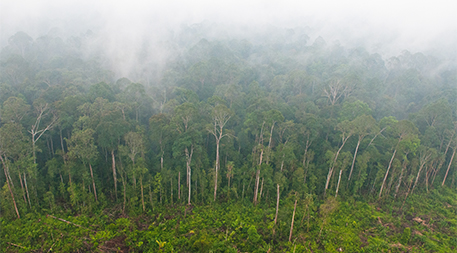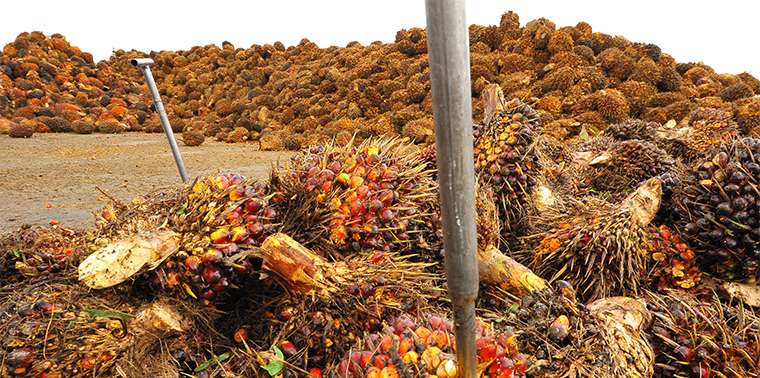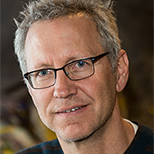November 3, 2014 — Last August, from the window of a jet high over Sumatra, I counted nearly a dozen plumes of smoke rising from the vast jungles and plantations below. Some more than a half-mile wide, they looked like pillars holding up the sky. That week the Indonesian Disaster Mitigation Agency detected 143 new wildfires in Riau Province, the area beneath my flight. All of the fires were almost certainly related to deforestation for timber operations and agriculture — predominantly oil palm cultivation.
Palm oil — which appears in a dizzying amount of food and cosmetic products, and is a feedstock for biofuel — poses many environmental problems. It’s the largest driver of Indonesian deforestation, which destroys habitat and contributes to climate change. And ponds of wastewater at palm oil refineries release immense amounts of methane, a greenhouse gas 34 times more potent than carbon dioxide.
Solutions to the environmental problems posed by palm production are complicated, partly because of palm oil’s ubiquity, but also because alternatives lack many of the benefits of the versatile oil. But they are out there.
Burning Below
A few days after I arrived in Riau, as I marched to the jungle to see one of the fires, I looked back at where my footprints sank some 12 inches into the peat and saw smoke rising from my tracks.
It’s here, in the peat burning below the forests, where the greatest climate impact from palm production can be seen. When forests are cleared to make way for oil palm plantations, the area is usually burned, and most of Riau’s massive fires burn on peat — swampy layers of partially decayed vegetation that spreads up to 60 feet deep beneath most of the province’s forests.

Fires associated with clearing land for oil palm plantations in the Indonesian province of Riau release massive amounts of carbon into the atmosphere and spread health-harming haze across the landscape. Photo by Aulia Erlangga for Center for International Forestry Research.
Peatlands hold up to 28 times as much carbon as rainforests growing on mineral soil. The peat is so carbon rich that if it is buried long enough, say for a million years or so, pressure, time and heat will turn it into coal. A single hectare of peatland rainforest can release 6,000 metric tons of planet-warming carbon dioxide when it’s converted into a plantation. Researchers estimated that in 2012 nearly 70 percent of the carbon released during the transformation of Sumatran rainforests into palm plantations came from peatlands, a 75 percent increase over their portion of emissions in the 1990s and an indication that palm is increasingly expanding into peat.
And it’s not just CO2: In 2013 the nation’s then president, Susilo Bambang Yudhoyono, apologized to Singapore and Malaysia for the brown cloud from Sumatran fires that shattered air pollution records in the neighboring nations, filled hospitals with tens of thousands of smoke-sickened patients and forced officials to close schools. Indonesian aircraft seeded clouds above the fires with 100 tons of salt in hopes of bringing rain to drench fires smoldering in the peat.
When the forests ignited again six months later, more than 9,000 tweets bombarded the president’s office. During an emergency trip to Riau he said he was “ashamed” of the fires. Nearly 50,000 Sumatrans sought treatment for the impacts of smoke on their lungs, eyes and skin. Aircraft again seeded the clouds.

Victims of habitat destruction driven in part by palm oil production, Sumatran elephants are now considered critically endangered by the International Union for Conservation of Nature. Photo by Vincent Poulissen (Flickr/Creative Commons).
The fires burn thousands of Indonesians out of their homes and destroy the habitat of endangered elephants, rhinos, tigers and orangutans. A United Nations report warned that no wild orangutans may exist outside protected areas by 2020. And at the current rate of habitat destruction, the International Union for Conservation of Nature estimated the Sumatran elephant could be extinct within 30 years.
“Effective action on the ground should be taken immediately to protect Sumatran elephants from extinction,” a report from the IUCN urged in 2013. “Especially in Riau.”
Getting Serious
In the past, Indonesia and the world paid lip service to stopping palm oil industry’s destruction of Indonesian forests and warming of the global climate, but more recently they have appeared to get serious.
In 2010 Norway promised $1 billion to Indonesia to keep its forests standing, and the next year Yudhoyono pledged that by 2020, with international assistance, the nation would reduce its greenhouse gas emissions by 41 percent from its “business-as-usual” trajectory. Last August, Singapore began imposing fines of up to $2 million on local and foreign companies that contribute to the haze from fires. The following month, Indonesia, after years of stalling, became the last of the 10 members of the Association of Southeast Asian Nations to ratify a treaty intended to reduce the smoke that has become a perennial strain on its relations with its Southeast Asian neighbors. Shortly afterward, at the U.N. Climate Summit in New York, 150 companies — including McDonalds, Nestlé, and Procter and Gamble — pledged to cut deforestation worldwide in half by 2020 and to eliminate it altogether by 2030.
In 2013 the world consumed 55 million metric tons of palm oil, nearly four times what it used 20 years earlier.Then, within days of taking office last October, Indonesia’s new president, Joko Widodo, proposed merging the country’s Ministry of Environment and Ministry of Forestry. That reform could help the nation meet its ambitious forest protection and emissions reductions goals if the Ministry of Environment, which negotiates with the U.N. and determines how the nation will meet its emissions goals, gains some authority over the nation’s forests and peatlands. On the other hand, the powerful and territorial Ministry of Forestry could usurp some of the Ministry of Environment’s authority.
“Combining exploitation and conservation authorities into one body does not guarantee balanced decision making,” Greenpeace Indonesia chairman Longgena Ginting told the Jakarta Post.
Palm Oil Boom
Ultimately, however, laws, treaties, government agencies and incentives will have little impact without fundamental changes to how palm oil is produced and consumed. And unfortunately, there are few viable alternatives to palm.
“There are benefits to palm oil which cannot be ignored,” Alan Townsend, dean of the Nicholas School of the Environment at Duke University, told me before I traveled to Indonesia. “Palm is one of the most productive crops on the planet, with the ability to grow in a remarkable range of places. Couple that with large profit margins, an incredible diversity of uses for palm oil and a lack of economically competitive substitutes, and you can quickly see why the industry has grown so rapidly.”
In 2013 the world consumed 55 million metric tons of palm oil, nearly four times what it used 20 years earlier. Indonesia and Malaysia satisfy 85 percent of the demand for the world’s most popular food oil. In 1985, Indonesia had less than 2,500 square miles of palm oil plantations. Twenty years later, they covered 21,621 square miles, and by 2025 the Indonesian government projects plantations will cover at least 100,000 square miles.
A month before my arrival in Riau a paper in the journal Nature Climate Change reported that in 2012 Indonesia deforested nearly twice as much land as Brazil, which until recently was destroying its forests faster than any other nation.
The exponential growth of palm oil plantations is to a large degree an unintended consequence of economics, and food and energy policies elsewhere in the world.
“There presently aren’t great alternatives to palm oil.” — Rhett ButlerIn 2006 U.S. food labels, under mandate from the Food and Drug Administration, began listing “trans fats” because they increase risk of heart disease. That led to a rapid increase in the use of tropical oils that aren’t trans fats, particularly palm. The television physician Dr. Oz promoted palm oil’s benefits to the heart and brain, helping drive a sixfold increase in consumption in the United States since 2000.
In Europe, efforts to avoid genetically modified foods pushed palm, which is so bountiful it hasn’t yet drawn much interest from genetic tinkerers. In China and India, the growing middle classes’ hunger for high-grade food oils can currently be satisfied only by palm.
The boom is fueled by what we drive, too. The increasing interest in biofuels is replacing the environmental damage associated with crude oil with the devastation palm production inflicts on tropical forests and the climate.
Some of the consequences of palm oil production, including deforestation and habitat destruction, have led to consumer boycotts. But such actions increase the demand for oil crops that are even more destructive to forests and the climate.
“There presently aren’t great alternatives to palm oil,” Rhett Butler, the founder of the rainforest reporting and research site Mongabay, wrote in an email. “If the goal is to meet growing global demand for edible oils, palm oil provides the most oil volume for a given patch of land. If one were to instead grow coconut or rapeseed, more land would be required to produce the same amount of oil.”
Promising Alternative
As demand for alternatives grows, however, that could change. In fact, one promising alternative oil to palm requires no land at all.The microalgae’s versatility makes them a good competitor with palm as a source of oil.
Solazyme, a California company, uses microalgae to produce oils for biodiesel that have already powered United Airlines jets and U.S. Navy ships. It’s expanded into oils for soaps, cosmetics and foods, which have higher profit margins than fuels. Last year consumer products powerhouse Unilever announced plans to use 3 million gallons of Solazyme’s algal oil instead of palm in an effort to lower its environmental impact.
“Think beer,” Jill Kauffman Johnson, the company’s director of sustainability, says, describing the vats in which Solazyme grows its algae. “A plant in Illinois is actually in a former Pabst Blue Ribbon plant.”

Microalgae cultivated by California-based Solazyme show promise as a source of palm oil substitutes. Photo courtesy of Solazyme.
“We can make a heart-healthy high oleic oil. The next day you put in a different strain and you can produce a sustainable alternative to palm or palm kernel oil,” she says. “It’s got the lowest level of polyunsaturated fats of any oil on the market, no trans fats and (grows) in a matter of days, not months in the field.”
The microalgae’s versatility makes them a good competitor with palm as a source of oil.
“Our goal is to try and help alleviate the pressure on the equatorial tropics,” Kauffman Johnson says. Since Solazyme’s algae grow wherever the company places its tanks, Solazyme can site its plants where they are most convenient to customers, partners and feedstocks, thus shortening supply chains. Cellulosic feeds such as switchgrass also minimize environmental impacts. The company just opened a 100,000-metric-ton plant in Brazil that uses sugarcane.
“Our technology is capable of ramping up very quickly,” Kauffman Johnson says.
Nonetheless, consumer tastes and agricultural economics are slow to embrace algae-based oils, so it will likely take years for these oils to replace more than a few drops in the flood of palm oil.
Doing Palm Better
A more immediate solution, Butler says, is cleaning up the palm industry.
“Establishing policies and best practices that avoid conversion of forests is something that companies can get behind,” he says. “There has been a groundswell of zero-deforestation commitments from buyers and producers in recent months.”
Philip Taylor, a postdoctoral scholar at the University of Colorado’s Institute of Arctic and Alpine Research who works with Townsend and has done extensive research in the tropics, says most palm plantations don’t produce the yields they are capable of.
Incentivizing the transfer of productivity-boosting knowledge among palm producers could make each hectare of plantation as productive as possible.“There are big gaps between what’s being achieved and what’s possible,” he says. “Right now the average yield in Malaysia and Indonesia is 18 ½ tons of fresh fruit bunches per hectare. In places with the best management practices, they’re already getting 30 tons per hectare.”
Yields of palm fruit, Taylor notes, have been stagnant since 1975, while in that same time, soy productivity has improved almost 100 percent.
“Some of it is knowledge based,” he says. “The right seeds in the right places, the right fertilizer at the right time.”
Incentivizing the transfer of productivity-boosting knowledge among palm producers could make each hectare of plantation as productive as possible. But the Union of Concerned Scientists, in its report Recipes for Success, notes that the increased profits that accompany improved yields can spur further expansion of plantations. Additionally, researchers from the UK and Singapore noted in a recent essay in the journal Science that increased yields and palm crops more suitable for growing in difficult conditions could lead to more land in Africa and Latin America being devoted to palm — both of which have yet to see the explosive planting of palm that has occurred in Southeast Asia. Therefore, improved yields must be accompanied by stricter protections of forests. Indonesia has had a ban on deforestation since 2011, but it’s riddled with loopholes. The Roundtable on Sustainable Palm Oil started certifying palm oil that met environmental standards 10 years ago, but many of its members continued to cut down forests. Last summer’s promises to stop the destruction of forests from government, palm producers and companies that use the oil show those efforts are strengthening.
“You have to have a moratorium on deforestation,” Taylor says, noting that the recent commitments by companies like Wilmar and Golden Agri to end deforestation is a significant step in the right direction. “These guys are a huge share of the palm industry,” he says.
If all of the more than 1,000 palm oil refineries worldwide turned their methane into electricity, it would reduce the climate impacts of the operations 34-fold.At the other end of the production chain, Taylor pointed to more low-hanging fruit for reducing palm oil’s environmental toll. Taylor’s and Townsend’s research shows that the methane released from palm oil refineries accounts for more than one-third of the palm industry’s impact on the climate, and a single pond of palm refinery wastewater annually puts out climate-warming gases equivalent to 22,000 cars. That methane could be used to make electricity by simply covering the pond and placing a biogas generator beside it. If all of the more than 1,000 palm oil refineries worldwide turned their methane into electricity, it would reduce the climate impacts of the operations 34-fold. Yet only 5 percent of the facilities do so.
In Indonesia, palm mills and refineries already generate their own electricity by burning the fruit’s solid waste. They’re usually far from the grid, and lack policies and infrastructures to feed the electricity into it. But they could send power to nearby villages.
“That’s being done by New Britain Palm and Musim Mas,” Taylor says.
Indonesia’s Sustainable Palm Oil initiative requires palm operations to begin developing biogas capture, which should speed more companies’ adoption of the technology.
And the hundreds of vehicles involved in the nation’s palm supply chain could burn liquefied natural gas — a transportation fuel that’s seeing rapid development elsewhere in Asia. In Riau Province, I passed neither a road nor an hour that wasn’t filled with bright yellow trucks loaded with scarlet bunches of palm fruit. All of those vehicles could run on a cheap and readily available fuel that would provide additional income to palm processors and mitigate their climate impacts.
“It’s going to happen in the next couple of years,” Taylor says.
But the coming years will also bring an increasingly ravenous hunger for palm oil. One producer, Asian Plantations, estimates that global demand for edible oils will more than quadruple by 2050. Palm will supply nearly 60 percent of that demand.
So perhaps the most important development in the search for palm oil alternatives is the sense of urgency. ![]()
Ensia shares solutions-focused stories free of charge through our online magazine and partner media. That means audiences around the world have ready access to stories that can — and do — help them shape a better future. If you value our work, please show your support today.
Yes, I'll support Ensia!


The Round Table in meeting soon for their RT12 seminar (http://www.rt12.rspo.org/) in KL with David Suzuki as keynote speaker. Unfortunately I am not in town to see this but it would be great if these events were more transparent. The industry has plant of money - they could afford to freely webinar these talks.
Would cheaper oils dampen the pressure to expand into forest land? If production was much expanded and distributed around the world, under a smallholder model then the price would be lowered. The problem may then be refining efficiency and FFB transport. New, efficient small scale PO mills needed.
I hear talk /rumor that soils are badly damaged after long term plantation activity. This would not surprise me as plantation soil management practices are hardly sustainable. Only now, are some plantations looking at their 3rd plantation cycle... is the land stuffed!
There is a new organisation being formed based in Malaysia by local and international scientist and researchers that will be focused on the palm oil industry. It will be looking hard at the many problems in the industry.
Current solutions like fire ban enforcement are 'bottom of the cliff' efforts. This could be done by turning the unwanted biomass into a valuable local commodity. I've blogged about a biochar based solution - how about growing carrots instead of waving burning sticks.
http://sea-biochar.blogspot.com/2013/07/haze-slash-and-palm-oil-plantations-in.html
This post describes trialling an intertwined social, environmental and economic solution that would need collaboration between a plantation company, local community, NGO's and local government. Let education and economics be the driver for change.
I have spent a number of years working to provide sustainable solutions to OP producers and have a couple of comments that might also help illuminate the issue.
• A company makes big money building a plantation. The numbers that were told to me (which I haven’t had the ability to verify directly) were that timber clear-cutting (prior to burning) nets approx. USD 10,000 per hectare while planting costs (after burning) amount to about USD 2,500. With the additional plantation costs (buildings, roads, etc.), the developing company still walks away with +/- 6,000 USD per hectare. This is why there is approx. 10mill hectares of already deforested land in Indonesia that few oil palm companies have touched (which only represents a cost of USD 2,500 per hectare to develop). This ample amount of available land can be used for plantations without creating (significant) new environmental problems, but the economics dictate that only virgin rainforest is of economic interest for development. The power of this to shape industry behaviour cannot be underestimated.
• I have been told privately by multiple OP executives that initiatives like the RSOP and, amazingly, even basic plantation worker training / safety programs have been undertaken to ‘keep the Europeans off our backs’. Unless you have travelled out to these very remote areas and experienced the local attitudes it is difficult to understand how different they are. Unless us Westerners understand this at a deep level and adjust our approach accordingly, I believe that this ‘attitude gap’ will continue to foil our well-meaning efforts.
Palm seemed the answer. Human greed is boundless. Thanks you Norway for your funds to help protect the environment.
Any biofuel producer should only use sustainable crops.
Only criticism is about algae oil. So far no one has demonstrated a viable method to extract the oil out of the algae. It isn't even close to being cost competitive with current fuels. It's not an alternative.
Why not elimination, rather than substitution?
This is a serious question. DDT was also ubiquitous, until it was highly contained in its usages.
Smallpox was eliminated in a coordinated global effort.
(Hydrogenation changes the saturation of fats in an oil. Hydrogenating a liquid vegetable oil - say, canola oil - changes its melting point, making it solid or semi-solid at room temperature. When the hydrogenation process is left incomplete - partially hydrogenated - it creates trans fats, which were found to have a strong effect in increasing 'bad' LDL cholesterol and decreasing 'good' HDL cholesterol, among other negative health effects. These partially-hydrogenated vegetable oils were promoted as a cheap and healthy alternative to animal fats like lard and butter, but turned out to be just as bad, if not worse.)
Palm oil was promoted as healthier during the trans fats scare, and it was cheaper than canola and coconut oils because of the higher yields. It also doesn't require hydrogenation, because it already solidifies at room temperature readily, making it suitable as a substitute for butter in baking as well. It was cheaper and seen as healthier than returning to animal fats.
But, it's been in wide use prior to the boom - people in the tropical belt across some parts of Africa, most of Southeast Asia, and some parts of South America, have used palm oil for cooking for centuries. They were only producing it on a very small scale though - which was why it was okay.
Many things produced on small scales aren't a problem - it's when you get to large-scale industrial production that the problems start. Small-scale agriculture was rarely a major environmental issue, but large-scale intensive industrial agriculture is environmentally damaging in almost every way.
To the world of less-preneur; Palm oil is the only way to make money. Thus they any which way to keep it.
To the surrounding socities of palm estates, you may take a assessment to prove that does Palm Oil is grace to their economy or hell.
I would like to educate the smal-holders to plant red seraya [Shorea spp] among their palm trees, some has intiated so. And it works. Because small holders were copy cats, they do what the monkey does
economically 6 years red-seraya may bring them great incomes, and good for the biodiversity
just think about...I know nothing justify devastation... but some agricultural themes should be treated carfully...
http://serendiworld.com/product-lines/serendipalm/
When the Europeans said they're proponent of free trade -- it's all lies, smokes and screens, when their MPs cast in stone their intention to erect protectionist artificial trade barrier against the world's leading oilseed crop: palm oil.
If you're serious about about saving the forest and environment, any criticism and reaction has to be proportionally with below verified global land use stats -- anything less is just fishy:
Millions
Acres--By
229-----Soybean
136-----Beef, Livestock, grazing and feed crops
67-------Rapeseed
56-------Sunflower
24-------Palm Oil